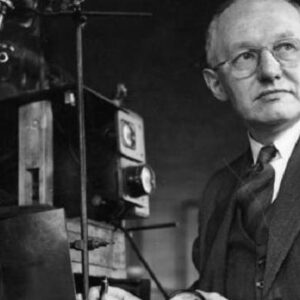Ernest Walton was an Irish scientist who, along with John Crockcroft, shared the 1951 Nobel Prize in Physics for his work on splitting the atomic nucleus. He was the first person to split the atom artificially and was essential in the development of nuclear energy. Born to a Methodist minister father, he frequently moved from town to town during his boyhood. He attended Methodist Belfast College as a boarder and excelled in science and maths. He received scholarships to study mathematics and science at Trinity College, Dublin. After receiving his bachelor’s and master’s degrees from Trinity, he was awarded a research grant to conduct research at Trinity College, Cambridge. In Cambridge University, he worked at the renowned Cavendish Laboratory under the supervision of Lord Rutherford, and he soon began collaborating with John Cockcroft on atom splitting, which ushered in a new era of nuclear physics. In addition, it contributed to the validation of other scientists’ theories regarding the atomic structure. Subsequently, he became a fellow at Trinity College, Dublin, where he spent the remainder of his career. Trinity College appointed him the Erasmus Smith Professor of Natural and Experimental Philosophy.
Youth and Early Life
Ernest Walton was born in Dungarvan, Ireland, on October 6, 1903, to Reverend John Walton and Anna Sinton. His family moved frequently due to his father’s position as a Methodist pastor, which necessitated the relocation of the entire family. In 1906, his mother passed away.
Throughout his childhood, he lived in various locations, including Rathleake and County Monaghan, among others. He attended Down and Tyrone schools before enrolling at Wesley College Dublin. In 1915, he became a border at Methodist College Belfast.
In 1922, he was awarded a scholarship to study at Dublin’s Trinity College. Four years after enrolling at Trinity College, he graduated in both honors mathematics and honors experimental science. He received his master’s degree from Trinity College in 1927.
Ernest Walton’s Career
In 1927, the Royal Commissioners for the Exhibition of 1851 awarded Ernest Walton a research scholarship, and he moved to Cambridge University to work in the Cavendish Laboratory under Lord Rutherford. Three years after joining Cambridge, the Department of Scientific and Industrial Research granted him a research award, and a year later, the university granted him a Ph.D.
In the early 1930s, he collaborated with fellow research scholar John Cockcroft to create an apparatus for bombarding lithium atoms with protons in order to split their nuclei. The series of experiments that the two scientists conducted confirmed the atomic structure theories proposed by scientists such as Rutherford. It was eventually referred to as the Cockcroft-Walton generator.
After working for five years at the University of Cambridge, he was named the Clerk Maxwell Scholar in 1932 and continued his research in the same capacity for the next two years. During his stay in Cambridge, he collaborated with some of the most brilliant minds in science at the Cavendish Laboratory, which employed four Nobel Laureates.
In 1934, he left the University of Cambridge to become a Fellow in the physics department at Trinity College, Dublin. In 1946, he was named Erasmus Smith Professor of Natural and Experimental Philosophy, a position he held until his retirement in 1974.
In addition to being one of the foremost researchers of his time, he was also renowned for being an excellent educator who could simplify complex theories for students. In his later years, he focused his study on radiocarbon dating, hydrodynamics, microwaves, the phosphorescent effect in glasses, and secondary-electron emissions from surfaces under positive-ion bombardment.
In 1952, he was appointed director of the School of Cosmic Physics at the Dublin Institute for Advanced Studies, and in 1960, he was named Senior Fellow of Trinity College.
Ernest’s Major Opera
His partnership with Cockcroft led to the creation of the Cockcroft-Walton generator, which confirmed the atomic structure and demonstrated how bombardment may be used to divide the nucleus of an atom. This is his most significant contribution. In addition to laying the foundation for a new era in the field of nuclear physics, his study earned him a share of the Nobel Prize in Physics.
Awards & Achievements
In 1938, the Royal Society of London awarded Walton and Cockcroft the Hughes Medal “for their discovery that nuclei might be dissolved by artificially manufactured blasting particles.”
In 1951, he and John Cockcroft shared the Nobel Prize in Physics for their work on “atom-smashing.”
Personal History and Legacy
Ernest Walton wed Freda Wilson, a fellow Methodist College student, in 1934. Two sons and two girls comprised the couple’s offspring.
Ernest Walton passed away on June 25, 1995, in Belfast, Ireland, at the age of 91.
Estimated Net Worth
Unknown.


